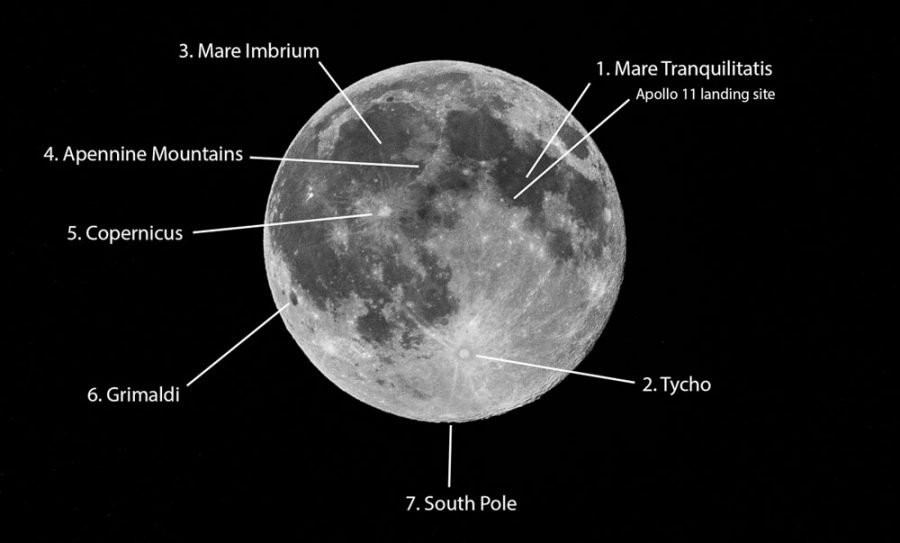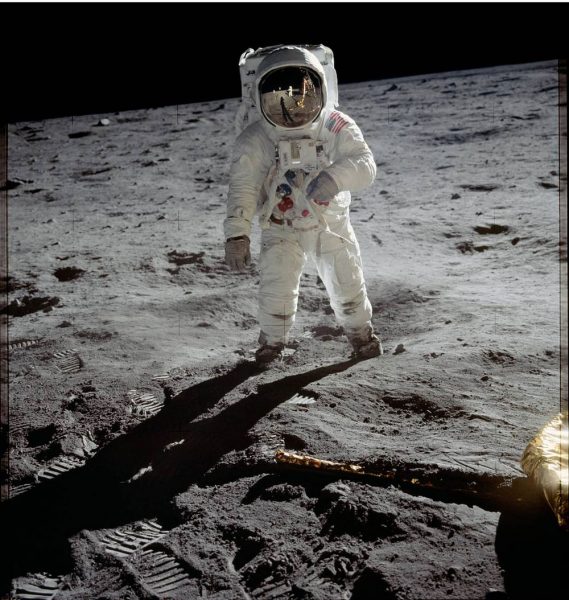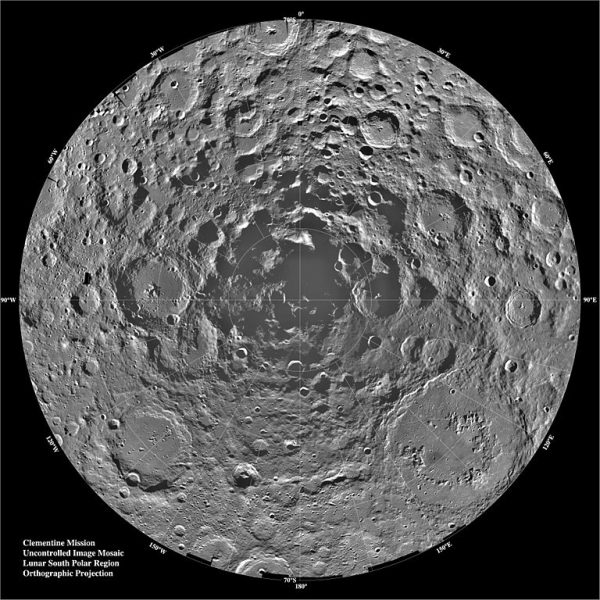Seven easy targets to explore when the Moon is full.
The night of April 26th will feature a full Moon. You may hear it called a “supermoon,” though that’s not a technical term, just a common expression to describe when a full Moon coincides with perigee, when the Moon comes nearest Earth in its nearly round orbit. Whether the effect is noticeable is debatable, but why not take advantage of it?
To get you started, here’s a list of seven fun — and easy — targets to explore. It’s important to note that you can see all of these features during any full Moon; the only advantage to a supermoon is that the entire globe appears slightly larger than usual. Also, if you’re thwarted by clouds on the 26th, you can always try a day or two before or afterward; the features will look essentially the same.

Daniel Johnson
A basic pair of binoculars will do the job, and even give you a sense of the Moon’s geological ruggedness. Stabilize the binoculars by bracing them (or bracing your arms) against something sturdy.
A small telescope at low power works great, too. However, astronomer Patrick Moore once noted that a viewer’s eye might be “dazzled” when viewing the Moon through a telescope with a low power eyepiece. (Somewhat counterintuitively, low magnification results in a brighter image.) If you find this to be the case, a simple lunar filter can be used to cut down some of the light while increasing detail contrast at the same time.
Alternatively, you can obtain detailed photos of the moon with a 300mm or longer lens on a DSLR or mirrorless camera.
Remember, a full Moon rises just as the Sun sets. Dusk is a great time for viewing, since the Moon is low in the sky and thus easy to find with your optical aid. And it’s a good time to invite the kids, since you don’t have to stay up late.
1. The Apollo 11 landing site
One of the best ways to feel a connection to the Moon is to locate the first place humans visited — the landing site of the Apollo 11 spacecraft Eagle. You’re probably familiar with the name of this location: Mare Tranquillitatis, the Sea of Tranquility. While the landing site itself, and the lunar lander we left there, are too small to resolve even with the best backyard telescope, the larger region is an easy target for viewing. (You can home in on the landing region if a have a larger telescope.)
To see Mare Tranquilitatis, just compare what you’re seeing through your optical aid with a simple Moon map or the labeled photo included here. A string of three connected circular dark areas — the relatively flat lunar mares — dominate the north-east corner of the Moon, and the Sea of Tranquility is the central one of these three. The Eagle set down on its south-west corner.
The Apollo 11 landing site was chosen strictly for practical reasons: Mission planners were looking for a smooth, somewhat crater-free location near the Moon’s equator. Even so, astronauts Neil Armstrong and Buzz Aldrin had to avoid two fairly large craters just before landing.

NASA
Later Apollo crews would explore even trickier landing locations. One target they considered, but rejected as too dangerous, is the magnificent crater Tycho.
2. Tycho
That takes us to Tycho, undoubtedly the crown jewel of lunar craters. Located in the lunar southern hemisphere, Tycho is more than 85 kilometers (53 miles) wide and features a large central peak. But the real attraction is the slew of rays — bright linear features emanating for hundreds of miles away from the main crater. The rays give Tycho a “splattered” appearance, like someone spilled a drop of milk, a visual indication of the impact’s power. The rays are best seen during a full Moon, so give it a try!
3. Mare Imbrium
Mare Imbrium, the Sea of Rains, is located in the northwest of the lunar face. It’s a colossal, roughly circular plain and, like the other mare, the dark basalt of its floor was once molten lava that has since solidified. Mare Imbrium’s eastern edge is ringed by another interesting feature: the Apennine Mountains.
4. The Apennine Mountains
Surprisingly like the Earth in some of its geology, the Moon has plains, valleys, and, perhaps most interestingly, mountains. Some lunar mountain ranges require careful telescope work to locate, but the Apennine Mountains are perfect for the beginner.
You can easily recognize the Apennine mountain range during a full Moon, unlike other lunar features that require a specific phase to see clearly. It’s a long and obvious part of the lunar landscape, and viewing something so familiar can help you think of the Moon as a real place.

NASA
5. Copernicus
If you imagine the Apennine Mountains as a pointer, you’ll notice that one end of the range aims almost perfectly at a large white circle surrounded by plains of dark basalt. That’s Copernicus, another large (93 kilometers wide) crater. Copernicus has a ray system, like Tycho, but it’s not quite as spectacular. Still, this is a remarkable feature with dramatic walls and a large central peak. Copernicus is an easy target when the Moon is full, but you might also give it a try during a different lunar phase when the shadows across the crater are longer. Shallower lighting will enable you to see the rugged terrain more easily.
6. Grimaldi
If you take the imaginary line of the Apennines toward Copernicus and extend it, hopping over Oceanus Procellarum, the Ocean of Storms, you’ll find a small, dark spot near the Moon’s western edge. That’s Grimaldi. Tycho and Copernicus are light-colored, but Grimaldi has a dark floor. The feature, which is classified a lunar basin rather than a crater, lacks a central peak and has two rims; the outer one spans 220 km. Grimaldi looks like a tiny mare because it’s filled with basalt, just like the larger dark areas of the Moon.
If you’d like to go a step further, you can try tracking down a “hidden” lunar basin near Grimaldi, as discussed in the August 2016 issue of Sky & Telescope.
7. South Pole
We started with humanity’s firstvisit to the Moon, so we’ll end with region that will likely host the nextlanding site: the lunar south pole.
You won’t have a direct view of the lunar south pole from Earth; objects on the edge of the Moon are said to be near its limb and are seen from an angle rather than straight on. But a small telescope will provide a good-enough view to see that this is a particularly crater-filled area — rugged and interesting.
If you’re serious and curious, identifying and mapping these craters is a worthwhile pursuit, but you can also just marvel at their sheer abundance. The craggy south pole region is definitely worth exploration from your backyard, with or without astronauts on the surface.

NASA / JPL / USGS
Remember as you explore, the Moon’s orientation changes throughout the night, so “down” isn’t necessarily “south.” Make sure you compare what you’re seeing to a photo or map. Also, some telescope eyepieces reverse north/south or east/west, so you might see a mirror image in your eyepiece.
The Moon is a perfect target for beginning astronomers: it’s impossible to miss, easy to study, and delivers an impressive view with modest equipment. And for the experienced stargazer, the Moon offers treasures aplenty. You just might discover that the Moon is “super” anytime!
 5
5









Comments
Tom Hoffelder
April 27, 2021 at 11:09 am
Thank you! "You may hear it called a 'supermoon,' though that’s not a technical term, just a common expression to describe when a full Moon coincides with perigee, when the Moon comes nearest Earth in its nearly round orbit."
"The Sun, though very bright, covers an incredibly small part of the sky. If you make a circle with thumb and forefinger and hold it out at arm's length, the size of the circle that just surrounds the Sun is the size of a pea. You can try this safely at night with the full Moon, since the Sun and the Moon have the same apparent size in the sky. Most people guess that the Moon might be the size of a Ping-Pong ball, but it is much, much smaller. "https://skyandtelescope.org/astronomy-news/observing-news/get-ready-for-may-9th-transit-of-mercury-041320162/"
A few percent difference in the size of a pea is still a pea. Sorry, I couldn't resist.
Your article is excellent!
You must be logged in to post a comment.
Anthony Barreiro
April 27, 2021 at 3:05 pm
Anything that gets people out looking at the sky is a good thing.
You must be logged in to post a comment.
Anthony Barreiro
April 27, 2021 at 3:11 pm
Thanks Daniel, this is a very helpful observing guide!
One more reason to observe the full Moon during twilight: less difference in brightness between the Moon and the sky, and your eyes aren't fully dark adapted yet, so you won't be blinded by the Moon's brilliance, as you would if you wait until after the sky is fully dark.
Another cool thing about craters with prominent rays: they're relatively young.
I walked up Bernal Hill here in San Francisco yesterday to watch the full Moon rise. Cirrus and altocumulus clouds were ever-shifting veils in front of the Moon, quite atmospheric. For a while we had a nice moonbow. There were a lot of people up on the hill to watch the Moon. They must have heard about the supermoon.
You must be logged in to post a comment.
Daniel_Johnson
April 27, 2021 at 6:20 pm
Thanks. Glad to hear the folks were out viewing and enjoying the Moon; it never gets old!
Good point about observing at twilight; depending on conditions you might even enjoy some subtle colors in eastern sky opposite the sunset.
You must be logged in to post a comment.
Anthony Barreiro
April 27, 2021 at 7:56 pm
Yes! I was pointing out the Earth's shadow and the belt of Venus to people up on the hill.
You must be logged in to post a comment.
You must be logged in to post a comment.